On surface drainage on city streets: types, purpose and rules of arrangement
The removal of rainwater from the streets is one of the sore issues among residents of many cities. It was raining a little, and there was no way to get to the entrance - a huge puddle formed on the way. You know the situation, right? But how can you get rid of her?
The solution to the problem lies in the proper arrangement of surface drainage on city streets. And what it is and what other problems this system solves - we will discuss all issues in our article. We will tell about the device of linear and point drainage, we will give recommendations on the selection of suitable materials. We also touch on the design, legislative regulation and installation of the system.
The content of the article:
What problems does the drainage system solve?
The problem of removing rain and melt water, as well as drains from watering and washing streets, is quite relevant in a modern city. To solve it, equip a surface drainage system - a set of trays, sand traps, drainage wells and other elements of engineering equipment assembled into a single drainage system.
Benefits of surface drainage
The drainage system effectively removes excess moisture and water from precipitation, sending it away from residential buildings, roads, parks, squares. That allows you to remove the hydraulic load on the roads and foundations of apartment buildings and cottages. And, as a result, extend their service life by 2-3 times.
Visually about the problems that arise due to improperly arranged drainage or its complete absence in the next photo selection.
As you can see, a properly designed and well-assembled drainage system has a number of advantages:
- You can improve the territory by planting flowers, shrubs, arranging recreation areas.
- The system allows you to protect the foundation of buildings from destruction, to increase the overhaul interval.
- Water will not accumulate and stagnate in basements and basements, which will extend their service life.
- The absence of an increase in humidity will prevent the formation and spread of mold, fungi and other harmful microorganisms.
- Timely drainage will allow to avoid leaching of soil and to extend the life of pavement, paving slabs.
In other words, the presence of surface drainage makes it possible to create comfortable conditions for the townspeople to operate streets, local territories, recreation and entertainment areas.
Drainage from various facilities
Due to frequent and sometimes intense precipitation, the issue of drainage is especially relevant - even 2 mm of precipitation in the city provide a drain. The reason for this is the waterproof coatings present in large quantities - this is asphalt on roads and yards, roofs of houses, etc.
Therefore, it is so important to collect surface water in a timely manner from the local area, parking lots, train stations, parks, squares, roads, bridges and other facilities. What the drainage system successfully copes with by collecting waste water and directing it to treatment facilities.
The importance of drainage from various territories in a city is difficult to overestimate. Thanks to a well-equipped collection system of melt and surface drains, the hydraulic load is reduced, which has a positive effect on the external condition of structures and objects, on the intervals between repairs and the duration of the total service life.
Types and device of surface drainage
The surface drainage system can be point and linear. Most often, to ensure the effective functioning of the drainage, these two types of drainage are combined. Next, we will consider what elements such systems consist of. We also talk about the materials from which individual elements are made to assemble the system, and the rules for choosing the right one.
Features of linear drainage
The linear type of arrangement of the drainage system allows you to quickly remove wastewater from a large territory, for example, along the perimeter of an apartment building, a stadium or from a roadway.
The linear drainage system consists of storm water inlets, protective gratings, containers for sand retention (sand traps) and other structural elements. The mounted system is connected to the sewer.
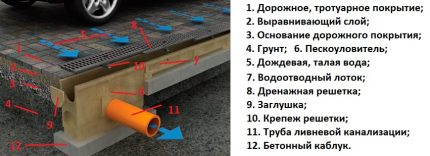
All components for assembling the drainage system are made of fiber-reinforced concrete, concrete, polymer concrete, plastic, stainless steel. Depending on the installation location and the expected loads, products of a standard or reinforced series are selected.
Consider their features on Standartpark product exampleconsisting of a base and reinforced series.
Series Products Basic (standard) involve use in low-traffic conditions - park areas, transitional sidewalks, sports facilities, cottages and improvement of the local area. The load class is A15-C250, which corresponds to a weight of up to 25 tons.
The hydraulic section of the trays is 100-300 mm. The material for manufacturing the elements: polymer concrete, fiber concrete, plastic (trays), stainless steel, galvanized steel, copper, cast iron (protective grilles).
Series Drive (reinforced) - the products are designed for operation under conditions of increased load from 25 to 60 tons, strength class from C250 to E600. It is intended for use in areas with heavy traffic, including heavy freight transport. They are made of plastic, polymer concrete and durable concrete. The hydraulic section (product design width) is 100, 150 and 200 mm.
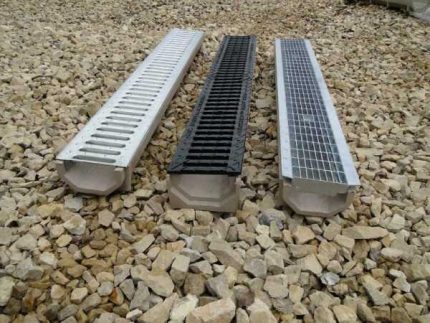
Reinforced series Max differs from the previous ones in the increased level of load - the products have a high strength class D400, E600 or F900, which allows them to withstand loads up to 90 tons.
Reinforced concrete, polymer concrete and plastic are used for manufacturing, reinforcing trays with galvanized nozzles. Lattices are made of impact resistant cast iron.
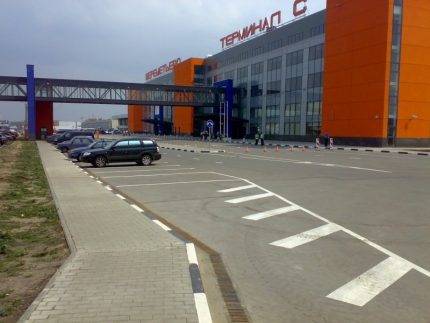
What is spot drainage made of?
Another type of surface drainage is local storm water inlets (point, local). They, like the linear system, collect drains to further direct them into the storm. But the collection takes place at one point - under the drainpipe, under the watering tap, at the entrance to the house, at the entrance and other places of the most likely formation of puddles.
The device and the main structural elements of the point system can be found in the following image.
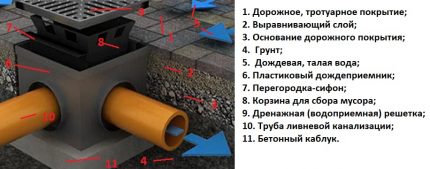
We will consider the characteristics of products for assembling a point system using Standartpark products as an example:
- Standard series Basic - a point drainage system, including a plastic rain collector and a water intake grill. It can be equipped with an additional waste basket and a siphon partition. Designs are intended for installation in places with a light load - the non-intensive movement of passenger cars and pedestrians.
- Reinforced series Max Designed for high and ultra high loads. Storm water tanks (wells) are made of polymer concrete and fiber concrete, reinforced with galvanized steel nozzles. Grids for protection of the storm water inlet are made of heavy-duty cast iron, which corresponds to the load of class D400 E600 and F900.
Storm water inlets can be used as sand traps or drainage wells. To build a well, you need to install several containers on top of each other, thus increasing the desired length. Multi-section storm water inlets are also used as inspection wells.
Point elements can be mounted together with a linear system - the reinforced series is suitable as sand traps for reinforced trays, the hydraulic section of which is 300, 400, 500 mm.

If you are interested in the arrangement of drainage for domestic use, we recommend that you look at the manufacturing and connection information homemade drainage well.
Material Guidelines
terms of Use - the fundamental criterion on which to rely when selecting elements of the system. Therefore, it is so important to consider where the system will be installed, what loads are expected, and the climatic features of the region.
Let's talk more about the nuances that should be considered when choosing equipment for the installation of a surface drainage system, and especially trays and protective gratings:
- load class;
- hydraulic calculation;
- bandwidth
- distance to the collector.
Strength class (load) - this is the maximum allowable weight, under the influence of which the product will not lose its performance. By production of trays are guided by the EN 1433 standard.
Water consumption or hydraulic calculation calculated in l / s, when calculating which take into account:
- precipitation intensity according to SNiP 2.04.03-85;
- runoff surface coefficient;
- drain area;
- The standard rainfall in the region.
The parameter is equally important bandwidth tray - that is, its ability to divert a certain amount of runoff per second. What is especially important with heavy rainfall or heavy snowmelt. For example, with a hydraulic diameter of 200 mm, the drainage capacity of a plastic tray is about 18 l / s, for concrete and polymer concrete products this figure is up to 11 l / s.
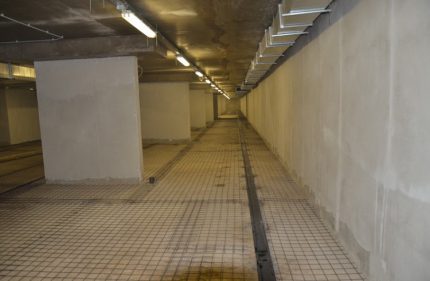
It is important that the high drainage capacity corresponds to the margin of safety of the individual elements from which the drainage system is assembled.
Subtleties of system design and installation
Designing and installing a drainage system is an initial task that should be carried out at the beginning of construction. At the same time, it is important to address the issue of sewage disposal, both in the city and in the country estate, in an integrated manner, taking care of surface drainage, the arrangement of storm sewers, household drainage, and landscaping.
How is a drainage project drawn up?
When designing a surface drainage system, it will be necessary to take into account a number of factors, including topography, amount of precipitation, type of soil, depth of groundwater distribution, type of facility, purpose and operating conditions of the facility.
To draw up a project, you should contact the design service, whose specialists will draw up the project in accordance with the norms and requirements of SNiP.
Why do you have to provide such documents:
- The general plan of the site where the dimensions and location of all buildings and structures are plotted.
- A site plan with a topographic survey of the area, with a designation of the location of the storage capacity of the effluent / drainage well.
- Technical report on the geotechnical conditions of the territory.
When drawing up the project, specialists will definitely select the suitable equipment for equipping the system with an indication of the strength class and the required number of structural elements.

Designing consists in calculations and choosing the optimal place for laying linear drainage.
The project includes the following calculations and schemes:
- Placement of linear drainage trays.
- Calculation of the hydraulic section of the trays, the selection of their optimal location.
- Location of sectional storm water inlets, taking into account the estimated points of maximum discharge of effluents.
- Connection points for drainage pipes (their slope angle) and inspection wells with an indication of their location on the plan.
- Mounting schemes for all elements of the drainage system - trays, storm water inlets, inspection wells.
- A comprehensive list of everything necessary for the arrangement of the system, elements - trays, storm water inlets, pipes, wells, manholes and all components.
Such a project will make it possible to implement an effective surface drainage system for a specific territory. For an example, you can go to the following link and see an example point drainage.
We have other articles on the design of drainage systems on our site:
- Site drainage project: selection of location, slope, depth, drainage system elements
- Calculation of storm sewers: an analysis of important design features
Key System Installation Rules
Installation of the system is carried out in accordance with the approved project and taking into account the recommendations of a particular manufacturer, from whom elements of a surface-type drainage system are purchased. By the way, all components are best purchased from one manufacturer, whose products suit you according to their characteristics and price category.
Next, we briefly consider the basic rules and stages of the installation of a surface drainage system.
First, with special grips, the workers manually lay and seal the water pipes. Then, a concrete “pillow” is poured into the trench, the thickness of which is indicated in the recommendations of the tray manufacturer. The cord marks the line for laying trays for drain assembly.
First of all, sand traps are installed, and then proceed to the installation of trays, installing them end-to-end. All connection points are sealed.
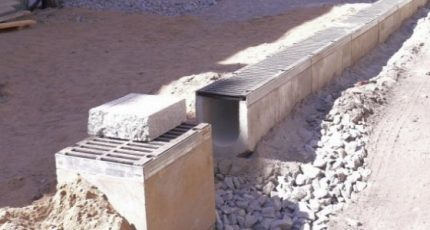
A linear drainage system is connected to a common sewage system through sand traps. It is also important to provide a point drainage device in places where water flows from the pipe.
As for the installation time of the system, then specialists, if minor volumes of work are expected, can cope even in one day.
Are you interested in the issue of arranging drainage in a private house? In this case, we recommend that you read this article.
Regulatory Drainage Requirements
The arrangement of surface drainage in a modern city is regulated by a number of documents, starting with design and ending with requirements for the quality of materials and their technical characteristics.
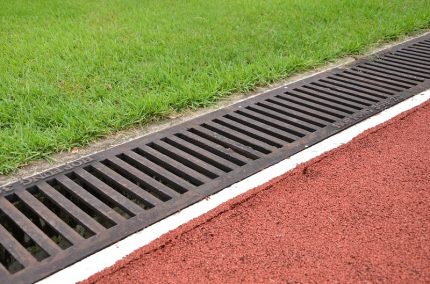
Next, consider the main ones:
- Arrangement of external sewage networks - SNiPa 2.06.15-85.
- Designing systems for protecting territories from flooding and flooding - SP 104.13330.2016.
- General norms for the construction and improvement of urban areas Town Planning Code of the Russian Federation dated December 29, 2004 N 190-ФЗ.
- General rules for the construction of buildings, structures and utilities - SNiP 12-01-2004.
- Drainage systems for road construction - STO 221 NOSTROY 2.25.103-2015.
- The device of drainage networks during the construction of airfields - STO 221 NOSTROY 2.25.114-2015.
- And other legal acts.
General requirements for materials for the arrangement of drainage systems are set out in GOST 33068-2014 (EN 13252: 2005). Recommendations for the calculation of drainage systems in the construction of roads ODM 218.2.055-2015. Technical conditions for storm water inlets are set out in GOST 3634-99.
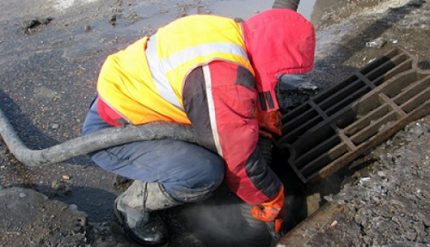
Conclusions and useful video on the topic
Guidance on the arrangement of a surface drainage system can be found in the following video:
A properly designed and installed drainage system will allow you to maintain an attractive appearance for the landscaped areas of a modern city, garden plots and private households. It will also extend the life of roads, bridges, foundations of buildings and residential homes, reducing the hydraulic load on the structure. But to create a drainage project, it is better to contact specialists who will take into account the type of soil, climatic features and a number of other important points.
Do you have your own opinion on the appropriateness of the device drainage system? Or do you want to supplement the above material with useful recommendations and facts? Write your comments, participate in discussions - the comment form is located a bit below.

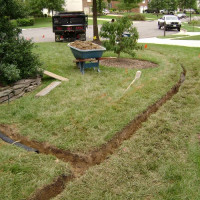 How to make garden drainage with your own hands: analysis of arrangement technology
How to make garden drainage with your own hands: analysis of arrangement technology 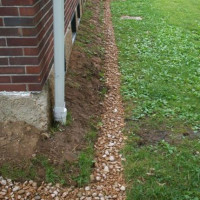 Wall drainage of the foundation: the specifics of the arrangement of the water drainage system
Wall drainage of the foundation: the specifics of the arrangement of the water drainage system 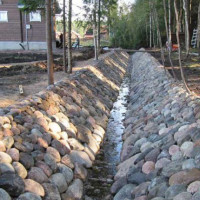 Slope of the drainage pipe: calculations, standards and features of the installation of drainage on the slope
Slope of the drainage pipe: calculations, standards and features of the installation of drainage on the slope  Drainage scheme around the house: the nuances of designing drainage systems
Drainage scheme around the house: the nuances of designing drainage systems 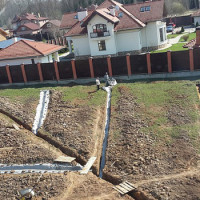 Do-it-yourself site drainage: features of the construction of various types of drainage
Do-it-yourself site drainage: features of the construction of various types of drainage  Site drainage project: selection of location, slope, depth, drainage system elements
Site drainage project: selection of location, slope, depth, drainage system elements  How much does it cost to connect gas to a private house: the price of organizing gas supply
How much does it cost to connect gas to a private house: the price of organizing gas supply  The best washing machines with dryer: model rating and customer tips
The best washing machines with dryer: model rating and customer tips  What is the color temperature of light and the nuances of choosing the temperature of the lamps to suit your needs
What is the color temperature of light and the nuances of choosing the temperature of the lamps to suit your needs  Replacement of a geyser in an apartment: replacement paperwork + basic norms and requirements
Replacement of a geyser in an apartment: replacement paperwork + basic norms and requirements